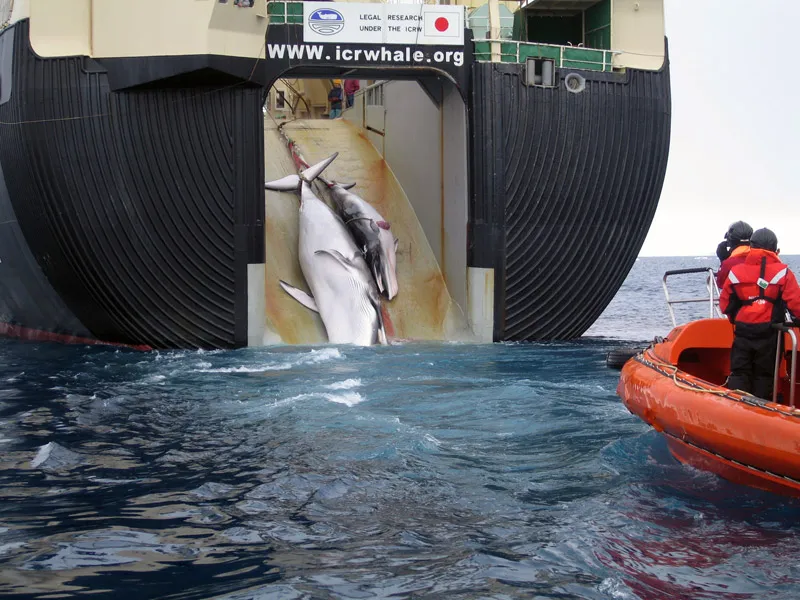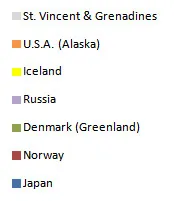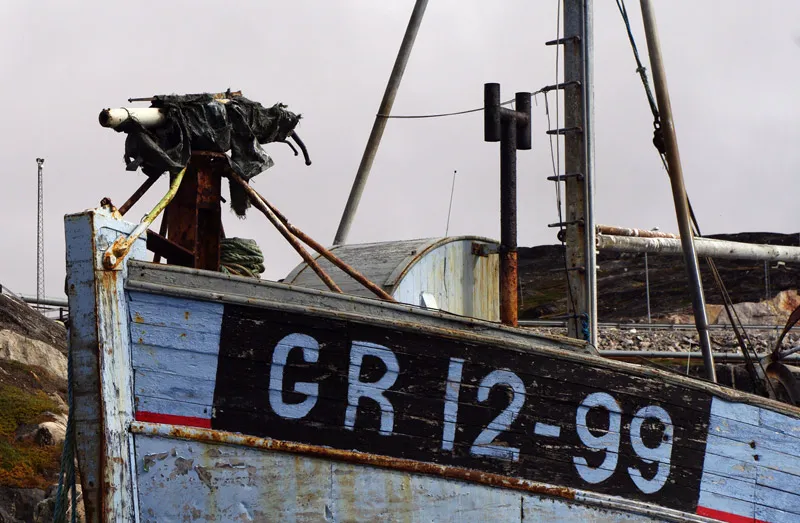Whaling in the 21st Century
Antarctic whaling | More on whaling

Mother and calf
Minke whales being dragged aboard a Japanese whaling ship under
the surveillance of Australian customs agents in 2008.
This led to a lawsuit filed by Australia in the International
Court of Justice in 2010.
The International Whaling Commission (IWC) was set up in 1946 to "regulate the orderly development of the whaling industry". It is widely perceived as failing in this task. From the 1970's onwards conservation groups began an intense international struggle aimed at saving whaling stocks from further depletion. The IWC had largely operated to ensure that whaling nations could share the whale stocks with a degree of fairness, rather than to conserve stocks for the future. It worked in a way that was more like the mining of a resource that would soon run out rather than managing a sustainable fishery.
The IWC oversees whaling in the world still.
There are now three categories of whaling:
1 - Commercial whaling - This officially ended in 1986 with the 1986/87 Antarctic season when 6,176 whales were taken worldwide. After this, the the catch limits for all commercial whaling was set to zero and officially still stands though since 1993 Norway and then Iceland from 2006 have exercised their rights to set national catch limits for coastal whaling operations for minke whales. Norway has been requested to halt this though has continued. From 1986 to 2019 Norway and Iceland were the only countries engaged in commercial whaling.
In 2019, Japan left the IWC and resumed commercial whaling around its own domestic waters, at the same time halting its 32 year "scientific" whaling operations in Antarctic waters.
2 - Aboriginal or subsistence whaling - The allowance of native peoples to hunt whales as they have for hundreds or thousands of years. Most of these people live around the Arctic, with some in the Caribbean. Despite its name, this kind of whaling is usually carried out with modern equipment, powered boats and explosive harpoons, sometimes supplied by the government of the country involved. Some of the whales hunted in this manner are endangered.
3 - Scientific whaling - Viewed by many as a controversial loophole to continue commercial whaling. Japan issued permits for scientific whaling in Antarctica every year from 1986 to 2018. In 2019 with the resumption of commercial whaling by Japan, the country has now ended its scientific whaling programme in Antarctica. Norway and Iceland have also issued permits for scientific whaling intermittently.
These figures are a snap-shot of a single year though have been similar for a number of years.

Whaling catches for 2012 by country.
Key:
Commercial whaling:
Iceland
and Norway
10 year trend, numbers falling
Scientific whaling:
Japan
10 year trend, numbers falling
Aboriginal whaling:
Greenland
(Denmark), Russia, Alaska (U.S.A.), St. Vincent and
the Grenadines.
All but St. Vincent and the Grenadines
are in the Arctic.
10 year trend, numbers broadly
stable from year to year.
Total 1,321 whales of 8 different species.
| 2012 Data | Japan | Norway |
Denmark (Greenland) |
Russia | Iceland |
U.S.A. (Alaska) |
St. Vincent & Grenadines | Total |
| Minke | 287 | 464 | 152 | 52 | 955 | |||
| Grey | 143 | 143 | ||||||
| Bowhead | 69 | 69 | ||||||
| Humpback | 10 | 2 | 12 | |||||
| Sperm | 3 | 3 | ||||||
| Sei | 100 | 100 | ||||||
| Bryde's | 34 | 34 | ||||||
| Fin | 5 | 5 | ||||||
| Total | 424 | 464 | 167 | 143 | 52 | 69 | 2 | 1321 |
 Whaling
catches 2012 by species and by country Whaling
catches 2012 by species and by country Of the species of whale caught in 2012, the Sei and Fin whales are endangered species on the Red List, the Humpback and Sperm whales are "vulnerable" while the Bowhead, Bryde's, Grey and are at risk and in need of conservation measures. |
Data from the IWC - International Whaling Commission

Whaling harpoon cannon at the front of a
fishing boat in Ilulissat harbour (West Greenland) 2010
Japanese whaling
The position of Japan to whaling since commercial whaling ended in 1986 has been controversial. While not the only nation that has hunted whales, it is the only nation that has done so outside of its own domestic waters, doing so in Antarctica which many have campaigned should be a conservation area. While the land and ice shelves of Antarctica are governed by the Antarctic Treaty, the seas around it aren't.
Japan's proposals put forward to take Sperm and Minke whales in Antarctica were criticized by the IWC because of the infeasibility of the proposed research methods. Many consider that "scientific whaling" is simply a continuation of commercial whaling under a different name.
Back in 2002 when I first wrote this page, I attempted to contact the Japanese Whaling Association (JWA) to invite them to submit scientific data or a link to such scientific data to this web site to explain the scientific findings from this research. I never received a reply despite following the initial request up.
"By collecting scientific
data, we aim to resume commercial whaling"
agriculture, forestry and fisheries minister
Yoshimasa Hayashi - March 2015
So "scientific whaling" has really always been about monitoring the whale populations to gain information about when commercial whaling can begin again. It has also had the effect of keeping alive whaling skills amongst the fishermen and keeping the idea of whaling and consuming whales alive amongst the Japanese public to preserve the market - so it could begin again one day.
Despite this however, it seems that the whalers may be up against the strongest of all oppositions - market forces. Young Japanese in particular simply don't like the idea of eating whale meat and blubber however the whales have been killed or "culled" according to the spin. So maybe whaling will end with the loss of a market for the whales.
Saving face?
While eating whale isn't popular with the Japanese public, the act of whaling itself had more support as it was seen that the rest of the world, particularly the West were trying to dictate what they can and can't do, something that was increasing with frequency and intensity in recent years with objections to whaling in the Antarctic. Stopping whaling all together would look like obedience to others.
By returning to commercial whaling in domestic waters only, Japan won't come under the jurisdiction of foreign courts and so if whaling continues for some time longer and eventually stops due to market forces, it has done so without outside influences - maybe. There are several thousand tons of frozen whale meat already in Japan from previous years "scientific whaling" expeditions that hasn't sold, adding to that by more commercial whaling doesn't seem to be the most sensible business idea.
The 2019 season from July to late December will aim to take 227 whales in total, 52 minke, 150 Bryde's and 25 sei whales . This is down from the 333 minkes killed in the last Antarctic whale hunt in the name of research and from nearly 1,000 in previous years.
Japan accepts court ban on Antarctic whaling March 2014
Antarctic whaling | More on whaling
Picture credits: Slipway - top of page - courtesy Australian Customs and Border Protection Service under Creative Commons 3.0 Share alike license
